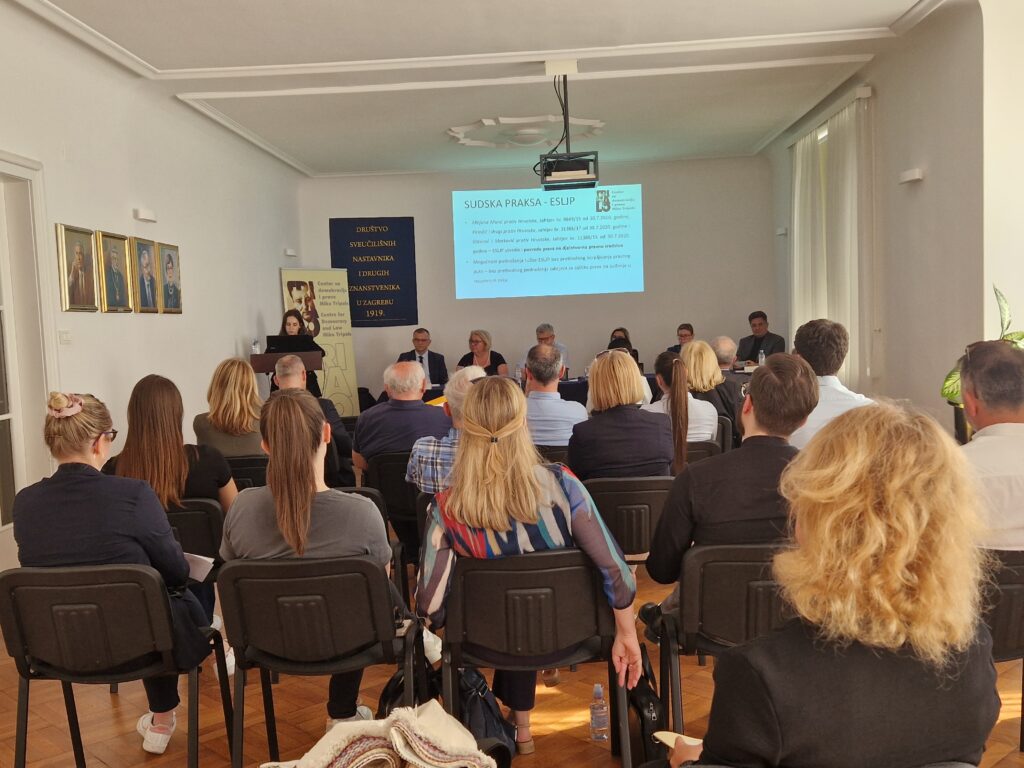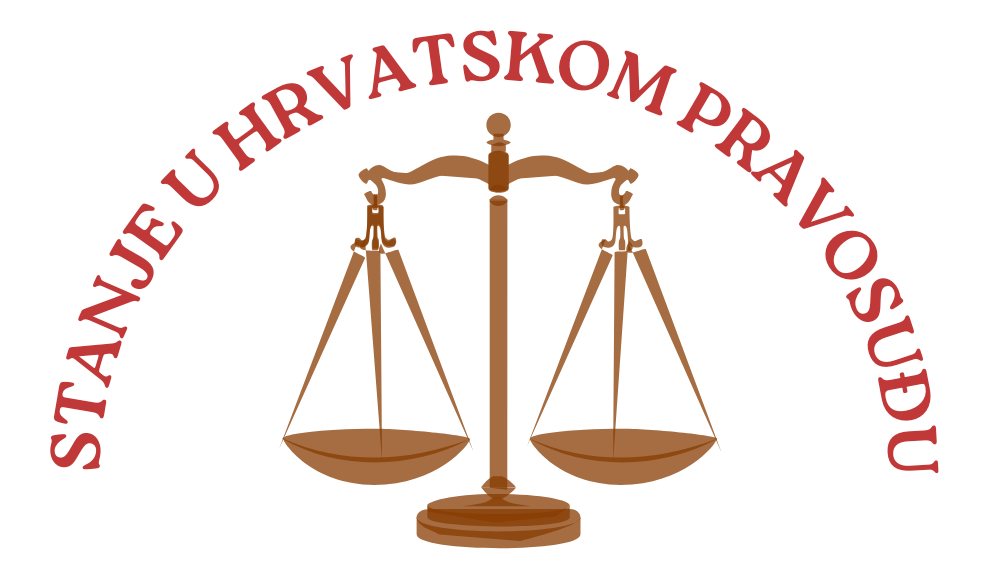Round table confidential investigation – violation of media freedom and criminal prosecution of victims, accused and defenders?
The Miko Tripalo Centre for Democracy and Law and the Croatian Journalists’ Association organized the round table Secrecy of the investigation – violation of media freedom and criminal prosecution of victims, defendants and defenders which was held on Monday, October 9, 2023, at 11:00 a.m. in Novinarski dom, Perkovčeva 2 in Zagreb.
The reason for the organization of this round table is the proposal to introduce a new criminal offense called “Unauthorized disclosure of the content of an investigative or evidentiary action”, which is currently in public consultation. The introduction to the topic was presented by Zlata Đurđević, a professor at the Faculty of Law in Zagreb and a member of the Miko Tripalo Centre, who was also the moderator of the Round Table, and Damir Kos, from the Supreme Court of the Republic of Croatia, also spoke about the topic; Elizabeta Ivičević Karas, from the University of Zagreb Faculty of Law, Dušan Miljuš, journalist and president of the HND branch in Jutarnji list, Igor Martinović, from the University of Rijeka Faculty of Law, lawyer Ljubo Pavasović Visković and Maja Sever, president of the European Federation of Journalists (EFJ).



Comments from the Miko Tripalo Centre on the 2022 Rule of Law Report and inputs for the 2023 Rule of Law Report
Download the comments at the following link:
Panel discussion RIGHT TO A TRIAL WITHIN A REASONABLE TIME IN RH
On Wednesday, June 14, 2023, the Centre for Democracy and Law Miko Tripalo held a panel discussion on the topic of the Right to a trial within a reasonable time in the Republic of Croatia in the hall of the Association of University Teachers and other Scientists in Zagreb.
After the welcoming words of Vedran Đulabić, the deputy president of the Centre’s Board of Directors, and the opening words of Neven Mates, a member of the Centre, the Centre’s associates, Matija Ninić and Ivana Zeljko, presented an analysis of the situation and gave an overview of the violation of the right to a trial within a reasonable time.
Alan Uzelac, member of the Miko Tripalo Centre and professor at the Faculty of Law in Zagreb, spoke at the round table; Juraj Brozović, from the Faculty of Law in Zagreb, lawyers Lidija Horvat and Renata Dozet Daskal and Nino Radić, president of the Commercial Court in Zagreb, which was followed by a discussion with the participants.
The focus of the gathering was on issues related to the duration of court proceedings, violations of the right to a trial within a reasonable time, and deficiencies in the means for speeding up the proceedings and achieving fair compensation.
You can download an analysis of the situation and a review of the violation of the right to a trial within a reasonable time, prepared by the Centre’s associates, Matija Ninić and Ivana Zeljko, at the following link:





Round table WHAT DOES THE NEW LAW ON PREVENTING CONFLICTS OF INTEREST BRING?
On October 25, 2021, the Miko Tripalo Centre for Democracy and Law organized a round table on the topic What does the new Law on the Prevention of Conflict of Interest bring?
During the discussion, we wanted to emphasize the key changes brought about by the Law and how the legal changes will affect the position of the Commission for deciding on conflicts of interest.
This meeting brought together anti-corruption and legal experts, representatives of political parties, the Ministry of Administration and Justice and the Commission for deciding on conflicts of interest, as well as the interested public. At the beginning of the round table, the participants briefly presented their opinions and proposals on the new legal regulation of conflicts of interest, followed by a discussion.
At the round table, the following participated:
Vedran Đulabić, Faculty of Law, University of Zagreb, member of the Gong Council and deputy president of the Miko Tripalo Center’s Board of Directors
Viktor Gotovac, Faculty of Law, University of Zagreb and President of the Assembly of the Center Miko Tripalo
Nikola Grmoja, Most
Davorin Ivanjek, Commission for deciding on conflicts of interest
Mirjana Juričić, judge of the High Administrative Court of the Republic of Croatia
Neven Mates, Centre for Democracy and Law Miko Tripalo
Nataša Novaković, Commission for deciding on conflicts of interest
Ivan Obadić, Faculty of Law, University of Zagreb
Dalija Orešković, Party with first and last name
Sunčana Roksandić Vidlička, Faculty of Law, University of Zagreb,
member of the Gong Council
Maja Vitaljić, Ministry of Justice and Administration of the Republic of Croatia
Round table HOW ARE CASES ALLOCATED IN COURTS IN RH?
Centre for Democracy and Law Miko Tripalo, on October 18, 2022, in hall 7 of the Faculty of Law in Zagreb, held a round table on the topic How are cases assigned to work in the judiciary in the Republic of Croatia?
Random assignment of cases to judges is one of the basic instruments for ensuring the impartiality and objectivity of trials. This prompted us to analyze the legal and sub-legal provisions on the allocation procedure. We were interested in whether the regulations ensure that cases are really assigned to judges at random or leave room for court presidents, court administration or even the Ministry of Justice to influence this assignment.
The introduction to the round table was given by Mr. Neven Mates, which you can read below:
After the introductory presentation, the gathering was addressed by Ivana Zeljko and Matija Ninić, students of the Faculty of Law in Zagreb and volunteers at the Miko Tripalo Centre, who presented the results of the conducted research:
Then the presenters, Srđan Gavranić, from the Commercial Court in Dubrovnik, Sanja Grgurić Hojski, from the Municipal Civil Court in Zagreb, and Alan Uzelac, from the Faculty of Law in Zagreb, presented their considerations and opened the discussion for all present.
Several judges pointed out in the discussion that the eSpis brought a number of positive changes and that it represents a very useful tool from the perspective of court presidents, which increased transparency and removed suspicions of favoritism. Criticism of legal solutions was expressed, but it was also pointed out that eSpis brought transparency and acceleration of procedures. With manual allocation, there was a greater possibility of influencing the allocation. With the introduction of automatic allocation, there is almost no such possibility.
The party has insight into the work of the case, and the exceptions to the award originate from the request for exemption, but they must be publicly justified and explained. Every action and use of the system is visible in eSpis.
At the same time, some participants warned that eSpis is completely kept by the Ministry of Justice and Administration, and the courts apply it, while they have no structural input into that system. On the other hand, the annual work schedule is the basic tool of the president of the court.
Although the infrastructure occasionally gets stuck, eSpis has saved a lot of time through e-communication because it has significantly reduced the delivery time.
There is a certain misunderstanding of IT terms, and confusion appears.
eSpis has difficulties (often of a technical nature), it is constantly updated in accordance with changes in laws and by-laws. The process has certainly been speeded up and there is no manual allocation. A lot of parameters are put in place to prevent possible prediction of who the item will come to.
Part of the participants think that the balancing of subjects every three months is very little used because everything is equalized anyway by the end of the year. The group that was less burdened will be the first to receive new items. During the year, corrections refer to cases such as longer sick leave, correction of mistakes, etc.
Some participants see circular allocation as a corrective to random allocation.
The gathering warned of cases of deviations from the norms in the past, when cases were assigned outside of the regulations, without being sanctioned. Sanctions for violation of regulations on the assignment of cases are not applied, disciplinary procedures have not been initiated. Randomization is most important in the most prominent subjects. Then, the rules that are applied are from by-laws, not from the law. They are treated as a technical act, and not as something that should guarantee the impartiality of the judiciary. Digitization must not be an excuse to move those things that should be widely discussed into the technical sphere. The permanent verification body designs the eSpis system and proposes changes to the Code, but the eSpis is something that should be widely discussed.
Regarding the framework standards, part of the participants believes that they are not perfect, but that they must exist. However, the second part believed that the criteria prescribed by the Minister of Justice and Administration are a relic of the past, and that the developed systems do not know this. They meet the current expectations of the Minister, but do not encourage judges to be efficient and achieve better results. Framework standards are an instrument of the unfortunate present evil or necessary evil. Instead, part of the participants advocated a system for real valuation. It was warned that the system creates more administrative work for judges, and that the norms are constantly increasing.



Summaries of survey results Application of information technology in the judiciary
You can read and download summaries of the survey results at the following link:
Round table APPLICATION OF INFORMATION TECHNOLOGY IN THE JUDICIARY
On May 17, 2022, the Miko Tripalo Centre for Democracy and Law held a round table on the topic of Application of information technology in the judiciary in the University Hall of Zagreb. The topic of informatization in the judiciary arose based on the first survey conducted by the Centre in 2020, in which judges and lawyers identified that there is a problem in that area.
The results of the survey on computerization in the judiciary, which was conducted in preparation for this meeting among lawyers and judges, were presented in the introduction. The main results are as follows:
- Dissatisfaction with current platforms
- The unreliability (instability) of the e-book platform, which often does not work or works only partially
- System maintenance is not announced in advance, and is performed during regular business hours instead of evenings or weekends
- The system is not adapted to the needs of users and is often changed
- Application development does not rely on close cooperation with users, i.e. judges
- Judges are burdened with entering a lot of data, instead of the court registrar doing it
- IT equipment is outdated
- There are problems in cooperation between the developers and the users themselves
- The ministry managing the IT system would have to significantly improve cooperation with judicial practitioners and experts in court proceedings and its computerization.
The panelists assessed that some developments in the use of IT systems are positive. Notifying the parties is much faster and it is possible to find out what stage the litigation is in. In the case of enforcement, the procedures are accelerated to a certain extent. However, there are also many problems: inappropriate algorithms, inconsistencies, platform congestion and very frequent system crashes. Amendments to the ZPP made it possible to hold hearings remotely, but this did not take root in practice. Access to case law is not available to the general public: judgments of first- and second-instance courts are not available to parties or lawyers, but only to judges, although all case law (with very few exceptions) should be available to everyone, especially to parties who, without an insight into it, cannot they can achieve adequate access to the highest judicial instances.
Currently, a large number of cases and persons are affected by the computerization of judicial processes. The average number of new cases per week in eSpis is 35,000, about 500,000 cases are updated per week, and there are 7,600 users, which does not include lawyers. All cases are recorded in eSpis, except for cases in the land registry, and the number of unique visitors is more than 100,000 per month.
The transparency of the system is still far from satisfactory. It should be achieved that eSpis really becomes a service that is open to citizens. For this purpose, better use should be made of the considerable resources available within the framework of European projects and funds. An obstacle to the improvement of the system is the large fluctuation of responsible persons and IT specialists in the system of the ministry responsible for the implementation of computerization, as well as other limitations in financial and human capacities.
The IT system should be the main tool for work so that the entire system becomes more functional. IT systems in the judiciary should be available 24/7 and there should be no interruption in service. Instead of spontaneous changes that are carried out under the pressure of too short deadlines in order to achieve goals that are not always clearly thought out and specified, attention should be paid to a permanent and systematic approach. Decisions on digitization plans, on priorities and their implementation should be reflected in the organizational structure of the relevant ministry, which should have a permanent and competent service for computerization at a much higher position.
There are problems in the functioning of eSpis in relation to the typology of data and their use for purposes of analysis and statistical processing. In relation to some vital issues, it is difficult to obtain accurate and representative data. There is a lot of data in the system that is difficult to find and use in the right way.
In order for the system to become really functional, it is first necessary to clearly set its goals. It is necessary to have realistic expectations from digitization and set clear indicators of success: is the judiciary more successful, more transparent, faster… For this purpose, it is important to enable innovation with the participation of all stakeholders, and also enable verification through the implementation of pilot projects.
Overall, it can be stated that there is still a lack of a vision for the development of the judicial system based on which the judiciary would then be successfully digitized. Croatia does not have an independent, responsible and permanent team of experts that could be “blamed” or “praised” for the progress in the digitization of the judiciary. Because of this, Croatia is increasingly lagging behind other EU countries. The Europeanization of judicial topics was an opportunity for the digitalization of the judiciary, because the EU through NPOO and other structural funds enabled the withdrawal of significant funds. Unfortunately, the opportunity was missed to fully functionally use the large amount of funds that the EU provided to Croatia for the digitization of the judiciary. The largest part of the funds for the reform is devoted to construction projects, and not to designing innovative services, opening up to the public and digital transformation of the judiciary. What the true informatization of the judiciary would require is: the original digital file (maintenance of files without a paper “original”); full publication of all relevant court decisions; high degree of automation of routine procedures (eg online courts for some minor cases); integrated public online discussions and full insight of the professional and general public into the e-procedure; synchronous insight into aggregate data and statistical analyzes relevant to the efficiency and integrity of the work of the judiciary, as well as planning the transformation of the judicial staff and judicial institutions, which includes a further reduction in the number of courts (especially appellate courts) and the retraining of the judicial staff who until now were tied to old, pre-digital practices (e.g. retraining of recorders into assistants in digitization).
Based on the discussion, the following recommendations are proposed:
1.optimization before digitization: business processes should be organized first (design a court procedure that will meet the needs and expectations of users) and then digitization should be introduced;
2.the goals of computerization and digitization should be systematically set in the spirit of the best European practices;
3.it is necessary to enable innovation and introduce changes based on realistic goals through the implementation of pilot projects;
4.digitalization management should be led by an expert and capable team that has the authority, autonomy and responsibility to introduce changes over a long period of time;
5.in the computerization process, it is necessary to listen to science and the profession and to include all stakeholders in an appropriate manner;
6.computerization should systematically enable the transparency of procedures and greater public insight into the operation of the judiciary;
7.access to the SupraNova system should be made available to the professional and general public (lawyers and parties) without delay;
8.the system should be designed in such a way that all data relevant to the evaluation of the system’s development (eg duration of proceedings, workload of courts, movement of personnel and financial resources, etc.) are available for monitoring the effectiveness and quality of the judicial system and the fight against corruption.
Below you can view and download the results of the survey and the PowerPoint presentation:


Comments from the Miko Tripalo Centre on the document Draft of the Law on Amendments to the Law on the State Judicial Council
Round table NATIONAL PLAN FOR THE DEVELOPMENT OF THE JUDICIAL SYSTEM FROM 2021 TO 2027
The Miko Tripalo Centre for Democracy and Law, at the invitation of the Club of Representatives of the Green-Left Coalition, organized a round table on the National Plan for the Development of the Judicial System from 2021 to 2027, in the Croatian Parliament, on April 5, 2022.
The National Judicial System Development Plan from 2021 to 2027 was conceived as a strategic document that should contain medium-term priorities that would improve and optimize processes in the judiciary.
The aim of this round table was to discuss some of the measures proposed in the Draft National Plan and possible proposals and amendments to that document.
The participants of the round table, Neven Mates, Centre Miko Tripalo, Alan Uzelac, Faculty of Law in Zagreb and Centre Miko Tripalo, Zlata Đurđević, Faculty of Law in Zagreb and Centre Miko Tripalo and Goran Selanec, judge of the Constitutional Court, referred to the following questions:
- Will the proposed measures do enough to increase the efficiency, transparency and accountability of the justice system?
- Are there any functional mechanisms for realizing the responsibility of judges?
- Will the measures in the National Plan solve the issue of slowness in passing judgments?
- Is the public guaranteed the work of the judicial system in accordance with democratic norms?
- What additional reforms are needed to resolve the situation in the judiciary, which were not mentioned in the National Plan?








